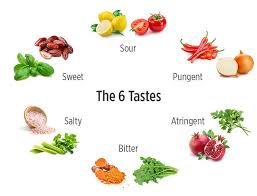The Multifaceted World of Tastes
Imagine a world devoid of tastes – a monochrome existence where flavors fail to dance on your palate, and every bite is as bland as the last. Tastes are the vibrant hues that paint our culinary experiences, adding depth, complexity, and pure delight to our meals.
From the sweetness of ripe fruits to the umami richness of aged cheeses, tastes come in a multitude of forms, each with its unique charm. Our taste buds, those tiny sensory organs scattered across our tongues, work tirelessly to decipher these intricate flavors and send signals to our brains, allowing us to savor and appreciate the diverse tastes that surround us.
Some tastes evoke nostalgia, whisking us back to cherished memories of childhood treats or family gatherings. Others challenge our palates with bold and unexpected combinations, pushing the boundaries of culinary creativity. Whether you have a penchant for spicy dishes that set your mouth ablaze or prefer the soothing comfort of creamy desserts, there is a taste out there waiting to captivate your senses.
Exploring tastes is not just about satisfying hunger; it’s an adventure in discovery and appreciation. It’s about understanding the nuances of ingredients, techniques, and cultural influences that shape the foods we love. By embracing new tastes and expanding our culinary horizons, we open ourselves up to a world of endless possibilities and sensory delights.
So let us celebrate the kaleidoscope of tastes that enrich our lives each day. Let us savor every morsel with gratitude and curiosity, knowing that behind every flavor lies a story waiting to be told. In this symphony of tastes, may we find joy, connection, and a deeper appreciation for the artistry of food.
Understanding Taste: Answers to 7 Common Questions
- What is taste?
- How does taste work?
- What are the basic tastes?
- Can taste preferences change over time?
- Why do some people have different taste perceptions?
- Are there cultural differences in taste preferences?
- How can I develop a more refined palate?
What is taste?
Taste is a sensory experience that allows us to perceive and appreciate the flavors of food and drink. It is a complex phenomenon involving our taste buds, which detect basic tastes like sweet, sour, salty, bitter, and umami. However, taste goes beyond just these primary flavors; it encompasses the nuances, textures, and aromas that make each dish unique. Taste is subjective and influenced by factors such as culture, genetics, and personal preferences. It plays a crucial role in our enjoyment of food, shaping our culinary experiences and connecting us to the world around us.
How does taste work?
Taste is a fascinating sensory experience that involves a complex interplay of physiological and psychological processes. When we consume food or drink, taste buds on our tongues detect basic tastes like sweet, salty, sour, bitter, and umami. These taste buds send signals to the brain via the nervous system, where they are interpreted and combined with other sensory inputs such as smell and texture to create our overall perception of flavor. Additionally, factors like genetics, culture, and past experiences can influence our individual taste preferences and perceptions. In essence, taste is a harmonious symphony of biological mechanisms and personal nuances that shape how we perceive the flavors of the world around us.
What are the basic tastes?
The basic tastes, also known as primary tastes, are the fundamental flavor categories that our taste buds can detect. These primary tastes include sweet, sour, salty, bitter, and umami. Sweetness is often associated with sugary foods and provides a pleasurable sensation on the palate. Sourness adds a tangy zest to dishes, while saltiness enhances flavors and can vary in intensity. Bitterness can be found in certain vegetables and coffee, adding depth to culinary creations. Umami, often described as savory or meaty, contributes a rich and satisfying taste that rounds out the flavor profile of many dishes. Understanding these basic tastes is essential in creating well-balanced and delicious meals that appeal to our senses.
Can taste preferences change over time?
Taste preferences are not set in stone and can indeed change over time. Our palates are dynamic and adaptable, influenced by a variety of factors such as age, exposure to new flavors, cultural influences, and even health considerations. As we journey through life, our taste buds may develop a newfound appreciation for tastes we once shunned or grow weary of flavors we once adored. This fluidity in taste preferences is a testament to the complexity of our sensory experiences and the ever-evolving nature of our relationship with food.
Why do some people have different taste perceptions?
The intriguing question of why some individuals have varying taste perceptions stems from a complex interplay of genetic, physiological, and environmental factors. Our taste preferences are influenced by genetic variations that dictate how we perceive different flavors such as sweet, salty, sour, bitter, and umami. Additionally, factors like age, culture, exposure to certain foods during childhood, and even personal experiences can shape our taste perceptions over time. This diversity in taste sensitivity not only adds richness to our culinary experiences but also underscores the fascinating intricacies of human physiology and behavior.
Are there cultural differences in taste preferences?
Cultural differences play a significant role in shaping taste preferences, influencing the flavors, ingredients, and cooking techniques that individuals and communities gravitate towards. From the bold spices of Indian cuisine to the delicate balance of umami in Japanese dishes, each culture brings its unique culinary heritage to the table. These preferences are often deeply rooted in traditions, history, and geographical influences, reflecting not just a preference for certain flavors but also a way of life. Exploring cultural differences in taste preferences offers a fascinating glimpse into the diversity of our world and the rich tapestry of flavors that define our culinary experiences.
How can I develop a more refined palate?
Developing a more refined palate is a journey that involves patience, curiosity, and an open mind. To enhance your ability to discern subtle flavors and nuances in food and drink, consider engaging in tasting exercises that challenge your taste buds. Experiment with a variety of ingredients, spices, and cuisines to expand your palate’s repertoire. Pay attention to the textures, aromas, and aftertastes of different foods to sharpen your sensory perception. Additionally, seeking guidance from experienced chefs, sommeliers, or food enthusiasts can provide valuable insights and tips on how to refine your palate further. Remember, developing a refined palate is not just about taste; it’s about cultivating a deeper appreciation for the artistry and complexity of flavors that enrich our culinary experiences.




